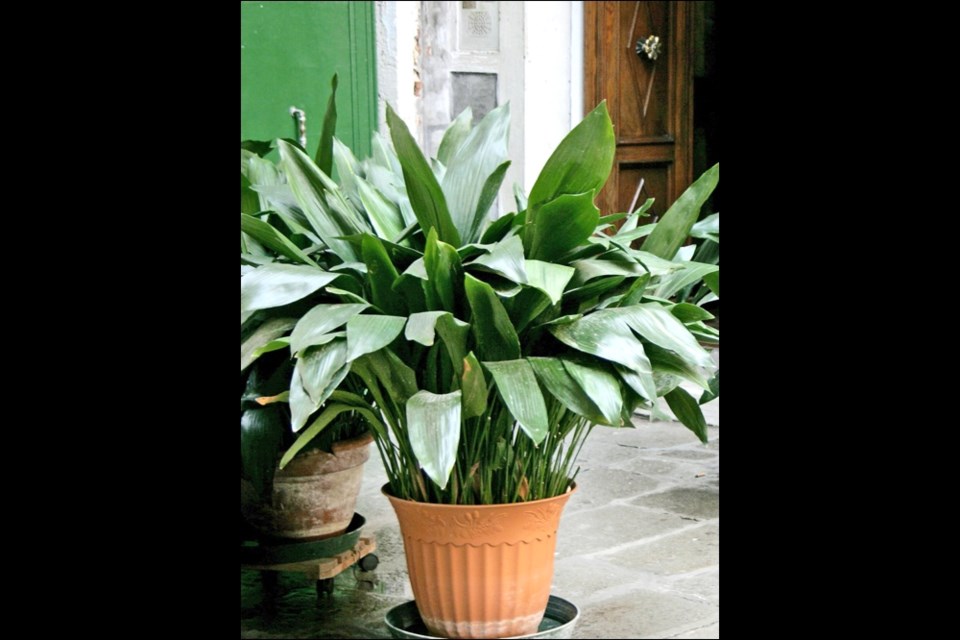Most of us have busy lives, too busy to take care of finicky indoor plants that require exacting care to thrive and reward us with flowers. For a short-term craving for something green with bright flowers, you can turn to seasonal plants like chrysanthemums and kalanchoes. But once these have flowered, it’s off to the dumpster or compost heap with them. For something a little more permanent, the following are easy-care and tough.
Spider plant (aka airplane plant, spider ivy, ribbon plant; Chlorophytum comosum) produces a six- to 12-inch tall mound of arching, green and cream striped, long grass-like leaves. Long runners, often two to three feet long with an occasional side branch or two, leap from the centre of the mound. A few small, short-lived, white flowers are produced along the runners. At the very ends of the branches, new plantlets or babies are produced. These eventually become large enough themselves to produce more runners, continuing the cascade of runners and plantlets. Brown leaf tips are common with low humidity, uneven moisture, too much fertilizer or fluoridated water. Simply trim back the brown ends and use distilled or rainwater if in Saskatoon. Grow as a hanging plant, on a high shelf or on a pedestal.
Chinese evergreen (Aglaonema commutatum and A. nitidum) is an excellent foliage plant with dark green and silver-white, gray or light-green variegated, lance-shaped leaves; some varieties also have red-pink undersides. It rarely outgrows its space, reaching no more than one to three feet tall and wide. It grows well in low indirect light near the window of a north facing room in moderate to cool temperature. A slow growing plant, expect it live 10 years or more.
The cast iron plant (aka bar room plant; Aspidistra elatior) — its name describes its constitution perfectly – is tolerant of low light, low humidity and a wide range of temperature. It does best if kept on the dry side. Like the Chinese evergreen, it is strictly a foliage plant. The most common variety has dark green, glossy, leathery leaves but there are a few cultivars with speckled, striped or narrow leaves. Expect it reach one to two feet tall. It spreads by underground stems, eventually expanding to fill its pot. The cast iron plant is a slow-growing plant, so start with as large a plant as you can find.
The snake plant (aka mother-in-law tongue, devil’s tongue, bow-string hemp, Sansevieria trifasciata and other species) is perhaps just as indestructible as the cast iron plant. I’ve seen them survive under Sahara-dry conditions, but they respond well to regular care (keep soil moderately dry). Long, leathery, sword-like leaves erupt from the soil in clusters forming a dense forest of green. One of the most common varieties, Laurenti, sports leaves with a bold yellow edge enclosing a dark and light green variegated leaf. Depending the variety, snake plants range in size from six to 48 inches.
And finally, there’s the aloe vera, perhaps the most common herbal home remedy that people turn to when sunburned or have other skin ailments in need of soothing. It is a short-stemmed succulent plant with long, pointed, flecked light green-gray, thick leaves lined with small teeth along their margins. It can reach three feet tall and wide. Grows best in bright light, shirtsleeve temperatures and moderately dry soil.
— This column is provided courtesy of the Saskatchewan Perennial Society (www.saskperennial.ca; hortscene@yahoo.com; www.facebook.com/saskperennial). Check out our Bulletin Board or Calendar for upcoming garden information sessions, workshops, tours and other events.



